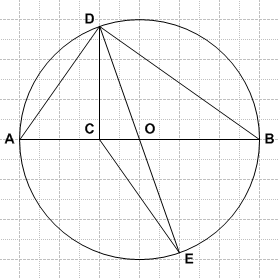2005 AMC 10A Problems/Problem 23
Contents
[hide]Problem
Let ![]() be a diameter of a circle and let
be a diameter of a circle and let ![]() be a point on
be a point on ![]() with
with ![]() . Let
. Let ![]() and
and ![]() be points on the circle such that
be points on the circle such that ![]() and
and ![]() is a second diameter. What is the ratio of the area of
is a second diameter. What is the ratio of the area of ![]() to the area of
to the area of ![]() ?
?
![[asy] unitsize(2.5cm); defaultpen(fontsize(10pt)+linewidth(.8pt)); dotfactor=3; pair O=(0,0), C=(-1/3,0), B=(1,0), A=(-1,0); pair D=dir(aCos(C.x)), E=(-D.x,-D.y); draw(A--B--D--cycle); draw(D--E--C); draw(unitcircle,white); drawline(D,C); dot(O); clip(unitcircle); draw(unitcircle); label("$E$",E,SSE); label("$B$",B,E); label("$A$",A,W); label("$D$",D,NNW); label("$C$",C,SW); draw(rightanglemark(D,C,B,2));[/asy]](http://latex.artofproblemsolving.com/c/b/0/cb0ec00bcfe88917a6048c2cc4aaab8088e8872f.png)
![]()
Solution 1
WLOG, let us assume that the diameter is of length ![]() .
.
The length of ![]() is
is ![]() and
and ![]() is
is ![]() .
.
![]() is the radius of the circle, which is
is the radius of the circle, which is ![]() , so using the Pythagorean Theorem the height
, so using the Pythagorean Theorem the height ![]() of
of ![]() is
is  . This is also the height of the
. This is also the height of the ![]() .
.
The area of ![]() is
is ![]() =
= ![]() .
.
The height of ![]() can be found using the area of
can be found using the area of ![]() and
and ![]() as base.
as base.
Hence, the height of ![]() is
is ![]() =
= ![]() .
.
The diameter is the base for both the triangles ![]() and
and ![]() ,
,
Hence, the ratio of the area of ![]() to the area of
to the area of ![]() is
is
![]() =
= ![]()
Solution 2
Since ![]() and
and ![]() share a base, the ratio of their areas is the ratio of their altitudes. Draw the altitude from
share a base, the ratio of their areas is the ratio of their altitudes. Draw the altitude from ![]() to
to ![]() .
.
![[asy] import graph; import olympiad; pair O,A,B,C,D,E,F; O=(0,0);A=(15,0);B=(-15,0);C=(5,0);D=(5,14.142135623730950488016887242097);E=(-5,-14.142135623730950488016887242097);F=(0.5555555555555555,1.5713484026367722764463208046774); draw(Circle((0,0),15)); draw(A--B);draw(D--E);draw(C--D);draw(C--E);draw(C--F);draw(A--D);draw(D--B); label("A",A,NE);label("B",B,W);label("C",C,SE);label("D",D,NE);label("E",E,SW);label("O",O,SW);label("F",F,NW); markscalefactor=0.2; draw(anglemark(C,F,D),blue);draw(anglemark(D,C,B),blue); [/asy]](http://latex.artofproblemsolving.com/5/e/9/5e9629039a8bbef0413de3c19a864acbdb600acc.png)
![]() .
.
Since ![]() , then
, then ![]() . So the ratio of the two altitudes is
. So the ratio of the two altitudes is ![]()
Solution 3
Let the center of the circle be point ![]() ;
Without loss of generality, assume
;
Without loss of generality, assume ![]() , so
, so ![]() and the diameter and radius are
and the diameter and radius are ![]() and
and ![]() , respectively. Therefore,
, respectively. Therefore, ![]() , and
, and ![]() .
The area of
.
The area of ![]() can be expressed as
can be expressed as ![]()
![]() happens to be the area of
happens to be the area of ![]() . Furthermore,
. Furthermore, ![]() or
or ![]() Therefore, the ratio is
Therefore, the ratio is ![]()
Solution 4
![[asy] unitsize(2.5cm); defaultpen(fontsize(10pt)+linewidth(.8pt)); dotfactor=3; pair O=(0,0), C=(-1/3.0), B=(1,0), A=(-1,0); pair D=dir(aCos(C.x)), E=(-D.x,-D.y); draw(A--B--D--cycle); draw(D--E--C); draw(unitcircle,white); drawline(D,C); dot(O); clip(unitcircle); draw(unitcircle); label("$E$",E,SSE); label("$B$",B,E); label("$A$",A,W); label("$D$",D,NNW); label("$C$",C,SW); draw(rightanglemark(D,C,B,2)); [/asy]](http://latex.artofproblemsolving.com/d/4/3/d4350c278972068aa00c47f368b984efb308fff2.png)
Let the point G be the reflection of point ![]() across
across ![]() . (Point G is on the circle).
. (Point G is on the circle).
Let ![]() , then
, then ![]() . The diameter is
. The diameter is ![]() . To find
. To find ![]() , there are two ways (presented here):
, there are two ways (presented here):
1. Since ![]() is the diameter,
is the diameter, ![]() . Using power of points,
. Using power of points,
![]() 2. Use the geometric mean theorem,
2. Use the geometric mean theorem,
![]() (These are the same equations but obtained through different formulae)
(These are the same equations but obtained through different formulae)
Therefore ![]() . Since
. Since ![]() is a diameter,
is a diameter, ![]() is right. By the Pythagorean theorem,
is right. By the Pythagorean theorem,
![]()
![]()
As established before, ![]() is right (if you are unsure, look up "inscribed angle theorem", this is a special case of the theorem where the central angle measures
is right (if you are unsure, look up "inscribed angle theorem", this is a special case of the theorem where the central angle measures ![]() ) so
) so ![]() is the altitude of
is the altitude of ![]() , and
, and ![]() is the base. Therefore
is the base. Therefore
![]()
![]() is the base of
is the base of ![]() and
and ![]() is the height.
is the height.
![]()
The required ratio is
![\[\frac{\left[DCE\right]}{\left[ABD\right]}=\frac{\frac{x^{2}\sqrt{2}}{2}}{\frac{3x^{2}\sqrt{2}}{2}}=\frac{x^{2}\sqrt{2}}{2}\cdot\frac{2}{3x^{2}\sqrt{2}}=\frac{x^{2}\sqrt{2}}{3x^{2}\sqrt{2}}=\frac{1}{3}\]](http://latex.artofproblemsolving.com/1/2/d/12d0064aa10059252428b83f111593fed6081547.png) The answer is
The answer is ![]() .
.
~JH. L
Solution 5
Assume the diameter is ![]() .
.
![]()
Get the height ![]() via power of a point.
via power of a point.
![]() .
.
By altitude of right triangle ![]() : Altitude from
: Altitude from ![]() to
to ![]() is same as altitude from
is same as altitude from ![]() to
to ![]() is
is  .
.
![]() and
and ![]() have the same (diameter) hypotenuse length, so their area ratio is their altitude ratio is
have the same (diameter) hypotenuse length, so their area ratio is their altitude ratio is
 .
.
~oinava
Video solution
See Also
| 2005 AMC 10A (Problems • Answer Key • Resources) | ||
| Preceded by Problem 22 |
Followed by Problem 24 | |
| 1 • 2 • 3 • 4 • 5 • 6 • 7 • 8 • 9 • 10 • 11 • 12 • 13 • 14 • 15 • 16 • 17 • 18 • 19 • 20 • 21 • 22 • 23 • 24 • 25 | ||
| All AMC 10 Problems and Solutions | ||
The problems on this page are copyrighted by the Mathematical Association of America's American Mathematics Competitions. ![]()










